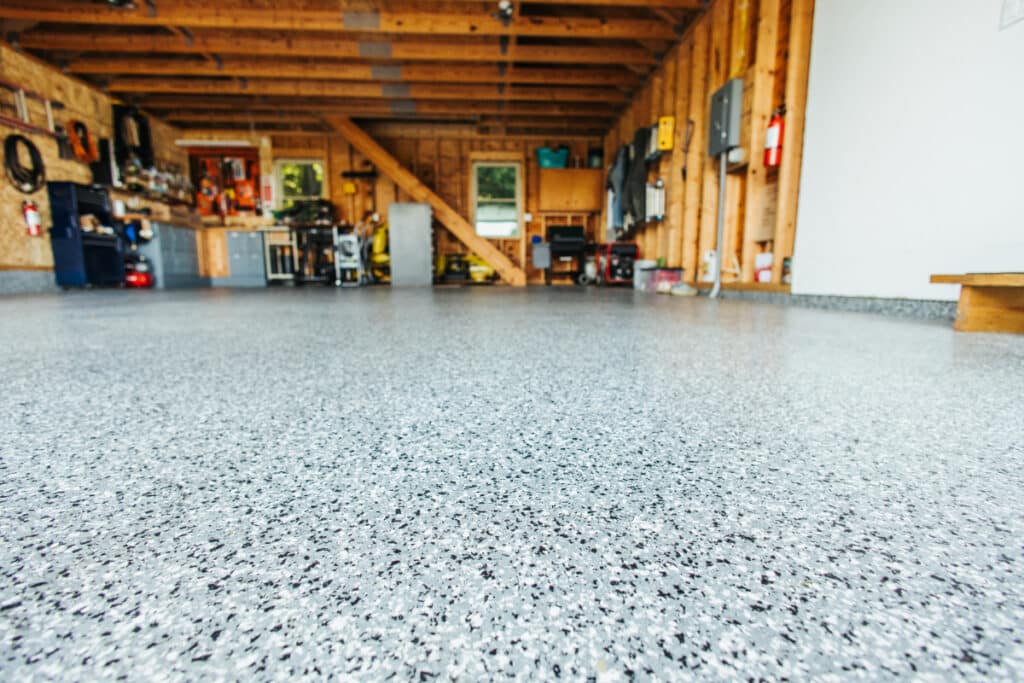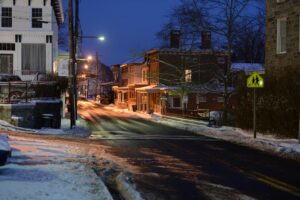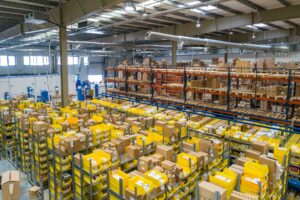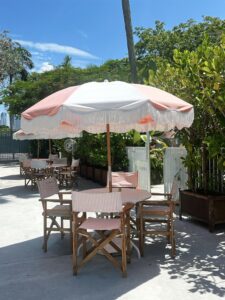Key Takeaways
- First, we’ll use the terms epoxy and polyaspartic interchangeably in this article because that’s what most people do, but the two are not the same. Polyaspartic coatings are the modern version of epoxy: they’re more durable, do not fade or yellow over time due to UV exposure, and are better able to handle hot care tires and the small fluctuations of underlying concrete. Overall, they are the modern, superior coating for concrete floors.
- Epoxy floors can be slippery when wet, but we have solutions. Our anti-slip floor coatings (we generally include in every installation) incorporate polypropylene or an aluminum oxide additive to create a slip-resistant, textured surface that still looks sleek and professional. Unlike silica sand, our anti-slip additive creates texture without making cleaning a hassle. Silica-based coatings often leave rough surfaces that trap dirt. Our polypropylene solutions provide slip resistance without excessive grit.
- Outdoor and high-traffic areas sometimes require extra grip. Whether it’s a commercial kitchen, a pool deck, or a garage floor coating, we customize the final floor coating for maximum grip.
Is Epoxy Flooring Slippery?
A common concern with epoxy floors is whether they are slippery or become slippery over time. The truth is that a smooth, glossy epoxy floor can be slippery, especially in wet conditions. This is common among epoxy floors that are installed by DIY-ers or property owners themselves.
But – and it’s a big but – professionally installed coatings usually include anti-slip additives to make epoxy or poly floors less slippery without compromising their durability or aesthetic appeal.
For garage floor coatings, commercial kitchens, or industrial settings, adding the right anti-slip floor coating is key to maximum grip and slip resistance.
How We Make Epoxy Garage Floors Less Slippery
Let’s quickly cover the basics of what we do, because it can provide some important context.
At Everlast Concrete Coatings, we do professional polyaspartic concrete floors. This is a high-performance protective layer originally developed for industrial applications, but they’ve become a go-to solution for garage floors, commercial spaces, warehouses, and outdoor surfaces due to their long-lasting finish and enhanced slip resistance.
When we install a flooring solution, we use polypropylene anti-slip additives to ensure our epoxy garage floors provide slip resistance without feeling rough underfoot. Unlike silica sand or grit-based solutions, our anti-slip coatings maintain a smooth surface while still offering traction.
For areas prone to wet conditions, such as pool decks and outdoor patios, we increase the amount of anti-slip additives to improve slip resistance and reduce the risk of slipping.
What Does the Anti-Slip Surface Feel Like?
Our coatings have a fine texture that enhances grip without being abrasive or rough underfoot. Unlike silica sand, which can create a gritty, sandpaper-like feel and even be clumpy, our polypropylene (some concrete coating companies use aluminum oxide additives, also called shark grip) provide traction without obvious roughness.
You won’t feel large, uneven particles underfoot – just a subtle texture that helps prevent slips while maintaining a smooth, polished look. The surface is designed to feel comfortable for bare feet, yet provide enough grip to reduce slipping hazards in garages, pool decks, warehouses, and commercial spaces.
So is it still easy to clean?
Absolutely. One of the biggest downsides of silica-based textures is that they can trap dirt, dust, and grime, making floors harder to maintain. Our anti-slip floor coatings avoid this issue. The fine-textured surface is stain-resistant and non-porous, making it easy to wipe up spills, sweep debris, or mop as needed.
Whether you’re dealing with oil drips in a garage, wet footprints on a pool deck, or heavy foot traffic in a commercial space, the floor remains easy to clean while maintaining maximum grip.

So, What Causes an Epoxy or Polyaspartic Floor to Be Slippery?
A bunch of factors contribute to how slippery epoxy floors can be:
1. A Completely Smooth, Glossy Surface
Without anti-slip grit or textured surfaces, an epoxy floor can become slick, particularly in wet conditions. While a high-gloss finish might look great, it can create a slipping hazard.
2. Wet or Moist Conditions
Epoxy floors can become particularly slippery in areas prone to moisture, including:
- Garage floors where water, snow, or road salts accumulate
- Pool decks and outdoor patios exposed to rain
- Commercial kitchens and warehouses with liquid spills
3. Oil, Dust, and Residue
Any surface contaminants, like oil drips, soap residue, or even fine dust, can make epoxy floors slippery by reducing traction.

Polyaspartic vs. Epoxy: Which One Provides Better Traction?
Both epoxy and polyaspartic coatings can be non-slip, but polyaspartic coatings cure faster, resist yellowing, and provide better durability in high-traffic areas. The benefits of polyaspartic have to do more with the formula then the anti slip grit or additives than anything else. What makes them superior to an existing epoxy coating or single coat epoxy?
- Faster Curing Time – Epoxy coatings can take several days to fully cure, meaning businesses and homeowners must wait longer before using their floors. Polyaspartic coatings cure in just a few hours, allowing for same-day use in some cases.
- UV Resistance – One of the biggest downsides of epoxy is that it tends to yellow or fade over time when exposed to sunlight. Polyaspartic coatings are completely UV stable, meaning they won’t discolor, even in outdoor settings or garages with exposure to natural light.
- Better Adhesion & Durability – Polyaspartic coatings bond exceptionally well to concrete, reducing the risk of peeling, flaking, or delamination – issues that are more common with older epoxy floors, especially in garages with hot car tires.
- More Flexibility & Impact Resistance – Unlike epoxy, which can become brittle over time, polyaspartic coatings remain slightly flexible, allowing them to withstand heavy foot traffic, dropped tools, and daily wear-and-tear without cracking.
- Stronger Chemical Resistance & Stain Resistance – Epoxy is known for being durable, but polyaspartic takes it a step further by resisting oils, gasoline, and even road salt, making it ideal for garages, commercial kitchens, and industrial environments.
- Temperature Tolerance – Epoxy coatings are sensitive to temperature changes and humidity during installation, which can lead to bubbling or improper curing. Polyaspartic coatings can be installed in a wider range of temperatures, making them more reliable year-round.
Read our full comparison of epoxy vs polyaspartic here: https://everlastconcretefloor.com/blog/polyaspartic-vs-epoxy/
Where Slip Resistance Matters Most: Is Epoxy Flooring Slippery?
So, when does the conversation about a non slip surface deepen with our customers? There are some situations where we will vary the amount of polypropylene in the clear coat / top coat.
- Garage floors – Prevent slips from wet tires, oil drips, and heavy foot traffic.
- Commercial kitchens – Maintain a non-slip surface in high-traffic workspaces.
- Outdoor applications – Pool decks, patios, and sidewalks need anti-slip additives to reduce slipping hazards.
- Warehouses and industrial settings – Improve skid resistance where floors see heavy equipment and liquid spills.
Get a Safe, Non-Slip Concrete Floor Coating Today!
If you want garage floor coatings or concrete coatings that are non-slip, durable, and easy to maintain, Everlast Concrete Coatings can help.
We provide concrete coatings in the Finger Lakes region, with free quotes and no-hassle consultations on properties of all kinds. Give us a call to learn more!






